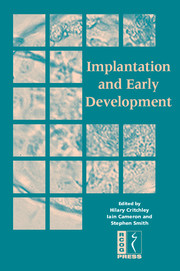Book contents
- Frontmatter
- Contents
- DECLARATION OF INTEREST
- Participants
- Preface
- SECTION 1 PREPARATION FOR IMPLANTATION – THE UTERINE ENVIRONMENT
- 1 Endocrine and paracrine signalling in the human endometrium: potential role for for the prostanoid family in implantation
- 2 Immunology of implantation
- 3 Progestin-indusced decidualisation promotes human endometrial haemostasis and vascular stabulity
- 4 Adhesion molecules and implantation
- 5 Vascular growth and modelling in the endometrium
- 6 Tissue remodelling the fetal-maternal interface: the regulation of matrix metalloproteinase 9 transcription
- 7 Embryo interactions in human implantation
- 8 Experimental models of implantation of the human embryo: reconstructing the endometrial–embryo dialogue in vitro
- SECTION 2 THE EMBRYO
- SECTION 3 LESSONS FROM ANIMAL MODELS (TRANSGENICS) AND NOVEL TECHNOLOGIES
- SECTION 4 CLINICAL SEQUELAE
- SECTION 5 CONSENSUS VIEWS
- Index
1 - Endocrine and paracrine signalling in the human endometrium: potential role for for the prostanoid family in implantation
from SECTION 1 - PREPARATION FOR IMPLANTATION – THE UTERINE ENVIRONMENT
Published online by Cambridge University Press: 05 June 2014
- Frontmatter
- Contents
- DECLARATION OF INTEREST
- Participants
- Preface
- SECTION 1 PREPARATION FOR IMPLANTATION – THE UTERINE ENVIRONMENT
- 1 Endocrine and paracrine signalling in the human endometrium: potential role for for the prostanoid family in implantation
- 2 Immunology of implantation
- 3 Progestin-indusced decidualisation promotes human endometrial haemostasis and vascular stabulity
- 4 Adhesion molecules and implantation
- 5 Vascular growth and modelling in the endometrium
- 6 Tissue remodelling the fetal-maternal interface: the regulation of matrix metalloproteinase 9 transcription
- 7 Embryo interactions in human implantation
- 8 Experimental models of implantation of the human embryo: reconstructing the endometrial–embryo dialogue in vitro
- SECTION 2 THE EMBRYO
- SECTION 3 LESSONS FROM ANIMAL MODELS (TRANSGENICS) AND NOVEL TECHNOLOGIES
- SECTION 4 CLINICAL SEQUELAE
- SECTION 5 CONSENSUS VIEWS
- Index
Summary
Introduction
The endometrium undergoes morphological and functional differentiation during the mid—late secretory phase of the menstrual cycle in preparation for implantation. Successful implantation is dependent on appropriate embryo development and uterine receptivity. The latter consists of differentiation and secretory transformation of the glandular epithelial cells followed by decidualisation of the stromal compartment during the mid—late secretory phase of the menstrual cycle. This period is also characterised by extensive tissue remodelling in the superficial layer of the endometrium in preparation for the invasion and implantation of the proliferating trophoblast cells. These changes are orchestrated by endocrine factors such as ovarian steroid hormones. However, local autocrine/paracrine signalling is also crucial in the preparation of the endometrium for successful establishment of pregnancy. A host of local factors are known to play a role in the implantation process. Some of these factors have been identified following null mutation of individual genes. Others have been implicated in the implantation process following observational studies of temporal and spatial gene expression during the window of implantation. More recent technological advances, such as application of cDNA array and proteomic technology, will outline valuable clues as to the hierarchy of molecular changes and events that culminate in the preparation of a receptive endometrium. A better understanding of the mechanisms that govern successful implantation is of clinical relevance as it will assist in the development of improved strategies to correct for pathologies associated with impaired implantation, early pregnancy development and uteroplacental function.
Keywords
- Type
- Chapter
- Information
- Implantation and Early Development , pp. 3 - 15Publisher: Cambridge University PressPrint publication year: 2005

